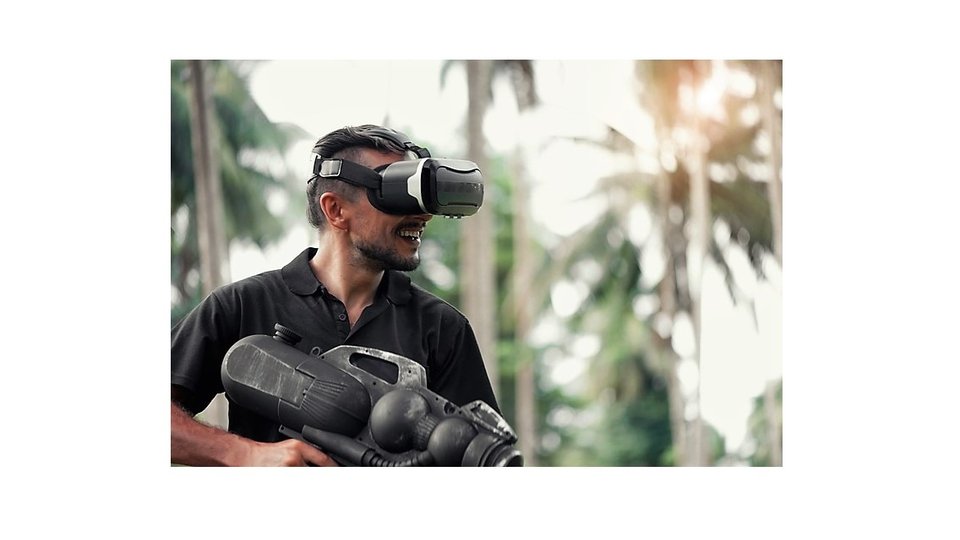Commentary
Mobile VR gains clout for post-pandemic entertainment
VR and simulator attractions in a mobile or containerized package is not new, but developments in this field of entertainment are accelerating in the post-pandemic environment.

June 7, 2021 by Kevin Williams
With the re-emergence of the entertainment scene following a long lockdown, many facilities are looking at being forced to adopt reduced capacity numbers and look at better utilization of their space. There has also been an increased interest in "transportable entertainment," with an immersive twist, to appeal to an audience still keen for entertainment but still concerned about crowded spaces. This has seen an explosion of interest in a traditional go-to from the entertainment industry's armory.
The deployment of VR and simulator attractions in a mobile or containerized package is not new. But developments in this field of entertainment are accelerating.
Simple concepts made mobile
The fairground business has deployed the first VR dark rides ("Dr Archibald: VR Ride") and trailer VR motion rides such as the "Rifter Mobile," with several unofficial conversions of the Chinese VR 9D egg rides mounted on traveling trailers. But the current developments being seen seem to be fueled by the re-emerging market's need for simple, popular and proven entertainment in a mobile package.
Chinese VR amusement and attraction manufacturer Leke VR recently started to promote its own interpretation of a mobile immersive entertainment offering. The company started to circulate concept images of its container solution, offering a selection of its most popular third-gen VR systems as a "Mobile VR Experience Center Solution." The ability to sell a selection of VR product ranges as a one-stop solution also allows the promotion of the VR arcade concept which the Chinese corporation has promoted leading up to 2020.
Korean manufacturer Sangwha is known for its dynamic motion experiences, and the company has converted its range of systems to be transportable. Taken to several of the Korean VR fairs, the company has released its "XR On The Go" trailer system. This offers an example of the "GyroVR" ride experience, offering extreme 360-degree motion entertainment, as well as the single rider "Flying VR" experience. The trailer system has been created as a simple to install mobile attraction to support fairs and promotional events. The mobility of this VR system enables it to go to where the crowds are.
Another developer of a large immersive 360-degree motion entertainment system is the new start-up, New World Rides, which recently launched a two-rider VR experience called "Roto Loco." The mobile attraction is placed in family entertainment center parking lots, making a dynamic motion ride experience available to venues that would normally not be able to accommodate this level of immersive attraction.
Forerunners: private events
For the amusement sector, the idea of mobility of attractions was previously represented by trailer-based private hire gaming events. The "gametrailer" approach to birthday party video game hire was an interesting aspect of the private hire/live-event scene.
Recently, the trailer-based entertainment offering has again come into its own. Other concepts include those from SpaceBuzz, the company behind a non-profit virtual education trailer system. The unit offers a VR-based education and outreach experience, using motion seats and VR headsets, and placing young minds in the footsteps of astronauts.
Containerization fosters innovation
The containerizing of an immersive entertainment offering has caught the attention of many new developers into the scene.
ImmersiveTech is a new corporation that comes with an extensive background in escape rooms and immersive development and has applied these skills to create the "Uncontained" VR entertainment platform.
This six-player, non-backpack, hyper-reality entertainment system brings all the popular aspects of a free-roaming VR experience to a facility in a portable, plug-n-play, containerized package. The experience comprises physical effects, developed to operate hygienically, allowing operators to place this system in external spaces and generate revenue from this kind of entertainment package.
The competition factor
A mobile, outdoor installation of free-roaming VR has also been considered, mixed with a competitive e-sports style of offering. PWXR, a division of Pillow's Willow VR studios, has been experimenting for some time with a highly active VR competitive experience.
The company has now encapsulated the experience, which is based on body tracking technology, into what is called the "active e-sports arena." Up to four players compete in 10-minute matches, offering a non-violent sports-like workout, as well as providing an audience experience using AR – cemented by e-sports streaming.
PWXR has started a dedicated rollout of the platform, and an outdoor mobile installation able to be placed in sports clubs, entertainment and leisure localities is key to the business plan.
Underwater adventures
One of the most transportable of the new VR attractions is one of the most innovative — that being "DIVR" from Ballast, taking place in a resorts pool where visitors don the waterproof headset, allowing them to virtually explore underwater wrecks, caves and submarines while swimming with sea life or adventuring in the sunken city of Atlantis.
They can also virtually fly down a mountain slope, over waterfalls and through canyons, or even explore the International Space Station. All packaged in a simple configuration of the waterproof headsets and interface.
Pop-up venues pop up
The temporary, or "pop-up," VR experience is not a new concept, and several developers have been creating VR attractions that while not on "wheels," are developed to be able to be dropped into a facility in short order, operated for a period, and then removed quickly. Recent examples would be the Capcom "Biohazard Walkthrough The Fear," an arena-scale VR experience.
These pop-up VR attractions have been seen at Taito Station, Sega VR Arena and the Bandai Namco VR Zone Portal sites. This is a concept which is now finding traction in the West.
The ability to create a highly mobile VR system allows manufacturers to benefit from available audience footfall, deploying an entertainment experience where they are, rather than trying to entice them away.
An example of the latest technology in deployment in this configuration was seen from Brogent Entertainment. The company installed at Kaohsiung Software Technology Park in southern Taiwan its latest product in the form of a 5G cloud computing-based dynamic simulation VR gaming system which allows for the deployment of the Brogent 5G VR E-sports Gaming Center.
Simple pop-up installations such as these can be placed in convenient high-foot-traffic locations.
Containerized entertainment concepts have gained traction post-pandemic, and the momentum is still in its early stage. More is on the way.
(Editor's note: Extracts from this blog are from recent coverage in The Stinger Report, published by KWP and its director, Kevin Williams, the leading interactive out-of-home entertainment news service covering the immersive frontier and beyond.)
About Kevin Williams
Along with advisory positions with other entrants into the market he is founder and publisher of the Stinger Report, “a-must-read” e-zine for those working or investing in the amusement, attractions and entertainment industry. He is a prolific writer and provides regular news columns for main trade publications. He also travels the globe as a keynote speaker, moderator and panelist at numerous industry conferences and events. Author of “The Out-of-Home Immersive Entertainment Frontier: Expanding Interactive Boundaries in Leisure Facilities,” the only book on this aspect of the market, with the second edition scheduled for a 2023 release.







